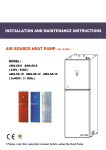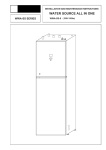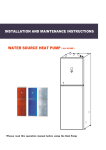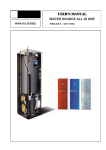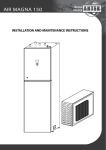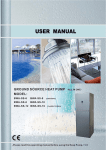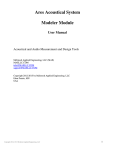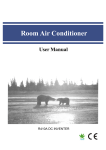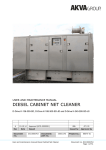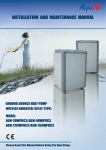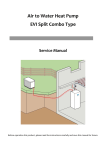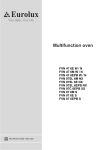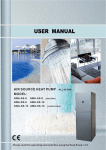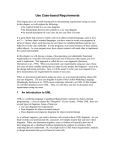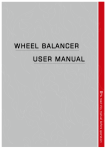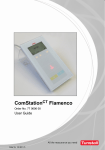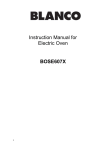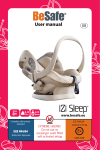Download Pipe connections
Transcript
INSTALLATION AND MAINTENANCE INSTRUCTIONS AWA-SS-6 AWA-SS SERIES AWA-SS-8 ( 230V / 50HZ ) AWA-SS-10 AWA-SS-12 AWA-SS-16 ( 3x400V / 3 / 50Hz ) 1 Contents System description Principle of operation ............................................ 3 Unit Description .................................................... 3 Principle of heatpump ........................................... 4 Control panel Layout .................................................................. Explanation .......................................................... Functions ............................................................. Symbols ............................................................... 5 5 6 6 General information for the installer Transport and storage ............................................ 7 Installation .............................................................. 7 Copper pipe connecting ........................................ 7 Inspection of the installation .................................. 7 Pipe connections General .................................................................. 8 Copper Pipe connections ...................................... 8 Pipe connection (heating medium) ........................ 9 Pipe connections (water heater) ............................ 9 How to connect the copper pipes ......................... 10 The step and diagram of collect refrigerant .......... 11 Pump capacity diagrams, heating medium side .. 12 How to adjust the rate of flow .............................. 13 Electrical connections Connect the power cord ....................................... 14 Wiring of the terminal (mode one) ......................... 15 Wiring of the terminal (mode two) ......................... 15 Connecting the room temperature sensor ........... 16 Connecting the outside temperature sensor ........ 16 Layout of the PCB ............................................. 17 1.5mm2 terminal connection ............................. 17 Part of wiring diagram ........................................ 18 2.5mm2 terminal connection ............................... 18 Wiring diagram ( 230v / 50 Hz ) ............................ 19 Wiring diagram ( 3X400v / 3 / 50 Hz ) ................... 20 Commissioning and adjusting Preparations ........................................................ 21 Filling and venting the heating medium system ... 21 Inspection ............................................................. 22 Adjust the heat medium pump .............................. 22 Readjusting, heat medium side ............................ 22 Emptying the water heater .................................. 22 Control General Information ............................................. 23 Menus .................................................................. 24 Main Menu Information ........................................ 24 Sub-menu Operation............................................. 24 Sub-menu Heat Curve ........................................... 25 Sub-menu Temperature ........................................ 26 Sub-menu Integral ................................................. 26 Sub-menu Operating Time .................................... 27 Sub-menu Reset ................................................... 28 Sub-menu Man Test .............................................. 28 Sub-menu DEFROST ............................................ 28 Adjustments to be made regularly ........................ 28 Heat Generation-General....................................... 28 Adjustment of the CURVE valve ........................... 29 Adjustment of ROOM valve.................................... 30 Adjustment of Part of the Heat Curve .................... 31 Adjustment the MIN and MAX valve ..................... 32 Adjustment of the HEAT STOP valve......................33 Graph of recent change in TEMPERATURE............ 34 Maximum Return Line Temperature ..................... 35 Warm water Production........................................... 35 Regular checks .......................................................36 Check of the Operating Mode ............................... 36 Checking the Water Level of the Heating system . 36 Checking the safety valves .................................... 37 In the event of leakage .......................................... 37 Alarm Messages .................................................... 38 Terminology and Abbreviations ............................. 39 Description of the switch board ............................. 40 Dealing with malfunctions Draining, heat medium side ................................ 41 Draining, water tank.............................................. 41 Draining, the chassis............................................. 41 Component placement Component positions 1 ........................................ 42 Component positions 2......................................... 43 Component positions 230 V / 50 HZ .................... 44 Component positions 3 x 400 V / 3 / 50 HZ ......... 44 List of components List of components ................................................ 45 Dimensions Dimensions and setting-out coordinates .............. 46 Dimensions of the AWA-SS-8 outdoor unit .......... 47 Dimensions of the AWA-SS-10 outdoor unit ........ 47 Dimensions of the AWA-SS-12 outdoor unit ........ 48 Dimensions of the AWA-SS-16 outdoor unit ........ 48 Accessories Accessories .......................................................... 49 Enclosed kit .......................................................... 49 Technical specifications Technical specifications 230 V /3 X 400 V ........... 50 System description 2 Principle of operation AWA-SS series consists of a heat pump, water heater, electrical module, circulation pumps and a control system. AWA-SS series is connected to the Outdoor Unit and heating medium circuits. The heat source of the AWA-SS series is provided from air. the Outdoor Unit of the system is a heat exchanger for collecting the heat of air. The air emits its heat to the refrigerant in the evaporate of Outdoorunit. It then vaporises and is compressed in the compressor. The refrigerant, the temperature of which has now been raised, is passed to the condenser where it gives off its energy to the heating medium circuit and, if necessary, to the water heater. After the condenser there is a built-in electrical module which cuts in if there is a high demand. Expansion vessel CW Heating Heating return flow HW The heating medium side and the hot water side must be fitted with the necessary safety equipment in accordance with the applicable regulations. Three - way valve Heating medium (VB), return Outdoor unit Liquid valve Heating medium (VB), flow Gas valve Heating medium pump Electrical auxiliary heater Condenser Compressor Compre Expansion valve 3 System description Unit Description In order to get the best results from the climate system AWA-SS series you should read through the section For the System manager in these Installation and Maintenance instructions. AWA-SS series is a climate system for heating houses and apartment buildings as well as industrial properties. Air is used as the heat exchange source. AWA-SS series is a complete heating installation for heating and hot water. It is fitted with new design on the market to be developed specifically for heat pumps. A new evaporator enables a new and improved circulation system for the refrigerant. The heat pump has an integrated 150 or 200 litre water tank and an immersion heater. The Tap Water Stratification system improves the efficiency of heat transfer by keeping the water in distinct thermal layers in the water tank. The unit is fitted with a regulating computer , which is controlled over a graphic display unit. Heat is distributed throughout the house over a hydronic heating system referred to as low temperature system with a maximal water temperature to radiators (supply line temperature) of 65°C. Most of the heating demand is taken care of by the heat pump (compressor unit), the auxiliary heater being started only when demands exceed available heat pump capacity. AWA-SS series consists of five main components: a. Heat Pump Unit Rotory or Scroll-compressor Stainless steel heat exchangers Circulation pumps for Brine sytem (brine) and heating systems Valves and safety equipment for refrigerant system, complete with necessary electric components b. Water Heater 150 or 200 litre Lined with copper sheet against corrosion or made of stainless steel Maintenance free as no anode is used c. Reversing Valve Opening or closing the connection to water heater according to operating mode: heating or warm water production d. Auxiliary Heater 3/6/9 kW electric heating element Three-step capacity control Fitted on supply line Delivers back-up heat in case of great heat demand that exceeds heat pump capacity Starts automatically, provided operating mode “AUTO” has been selected e. Regulating Equipment The regulating system controls heat pump components (compressor, circulation pumps, auxiliary heater and reversing valve). Based on data received from sensors, it starts or stops heat pump operation and determines whether heating or warm water shall be produced. The system consists of: Control computer with graphic display unit Temperature sensors (outside air,room, supply line, return line system) System description 4 Principle of heat pump A heat pump can exploit the energy contained in natural heat sources. Or, to put it differently, the heat pump ”collects” heat energy from the heat source. This makes the heat pump a very environmentally friendly and economically sound alternative for space heating. a. The Outdoor unit is used as the heat pump’s evaporator. Here the heat energy of the Outdoor Unit causes the refrigerant, circulating through the evaporator, to boil and turn into a gas – it evaporates. b The refrigerant, having absorbed heat energy, is circulated to the compressor where pressure and temperature are raised. c The refrigerant continues to the condenser. When condensing, it releases heat energy to the heat carrier, circulating through the condenser. The temperature of the refrigerant sinks, and it returns to its liquid state. d The heat energy released is carried by the heating circuit to water heater and radiator or floor heating systems. e At last the refrigerant is led through the expansion valve, where its pressure is reduced, and then continues to the evaporator The process is restarted. . The heat pump has two separate liquid circuits Refrigerant circuit – circulating inside the heat pump. Through evaporation, compression and condensation it absorbs energy from the outdoor unit and releases it to the heat carrier. The refrigerant is chlorine-free. Heating circuit – water transporting heat energy to the heating system (radiators/floor coils) and the water heater. Condenser Expantion valve/ pressure drop Heating Circuit Compressor/ pressure increase Refrigerant Refrigerant Circuit Evaporator Fan 5 Control panel Layout o ROOM 20 C Display Up button OPER. AUTO Left button C DRight button Down F button Power On/Off A Explanation Control Panel The control panel of AWA-SS features a graphic display five control buttons . Beside the control panel you will find the User’s Manual, a short description of how to increase and reduce room temperature, and a label with name and phone number of dealer. o ROOM 20 C OPER. AUTO Graphic display Control panel 6 Functions The control computer is operated with the help of a user friendly menu system that is displayed on the contr ol panel. There is a main menu and four sub-menus accessible from the main menu. The menus are described in detail further down. To be able to select the desired menu and increase or reduce preset values, you will use the five buttons. • • • • • One butto n poin ting One button pointing One button pointing One button pointing One button pointing upwar ds marked with a plus downwards marked with a minus to the right to the left to the Power ON/OFF Symbols For you to know at a glance the actual operating mode of the heat pump, one of the following symbols will be shown in the lower part of the display depending on which part of the unit is working: The heat pump is running. Warm water is being produced. The auxiliary heater is activated. The figure next to the symbol indicates capacity step. Indicates the status of warm water production. If the symbol is empty, warm water temperature is 44°C. There is a heating demand. If the symbol is full, warm water temperature is the start temp. + 4°C. 7 General information for the installer Transport and storage Inspection of the installation The AWA-SS series must be transported and stored upright and dry. The AWA-SS series may however be carefully laid on its back when being moved into a building. Current regulations require the heating installation to be inspected before it is commissioned. The inspection must be carried out by a suitably qualified person and should be documented. The above applies to closed heating systems. If the heat pump is replaced, the installation must be inspected again. H M flo w 4 9 (5 °C 0) H o t w a te r5 1°C 0 -2 +2 1 0 0 R +2 0 -2 H M flo w4 9 (5 °C 0) H o t w a te r 5 1°C 1 R Installation AWA-SS series is placed on a firm base, preferably a concrete floor or foundation. Install AWA-SS series with its back to an outside wall, ideally in a room where noise does not matter. If this is not possible, avoid placing it against a wall behind a bedroom or other room where noise may be a problem. Any wall that backs on to a bedroom should be fitted with sound insulation. Route pipes so they are not fixed to an internal wall that backs on to a bedroom or living room. Copper pipe connecting 1) The maximun length of the connecting copper pipe between the mainframe and outdoor unit is 15 meters. 2) There is no need to charge extra refrigerant into the copper pipe while its length is less than 5 meters. 3) While the copper length is more than 5 meters, copper pipe while its length is less than 5 meters.every extra 10g refrigerant must be charged for per increased 1 meter length. Pipe connections 8 General Pipe installation must be carried out in accordance with current norms and directives. The heat pump can operate up to a return temperature of about 58* °C and an outgoing temperature of about 70* °C from the heat pump. The compressor produces up to 65* °C, the rest is obtained using additional heating. The other heat pumps has a max return temperature of approximately 50 °C and an outgoing max temperature from the heat pump of approximately 60 °C. Since the AWA,AWB series is not fitted with shut-off valves, these must be fitted outside of the heat pump to make future servicing easier. During assembly the pipes for the heat medium and water heater and possibly hot water circulation are routed backwards. The distance between AWA-SS series and the wall ought to be 50 mm. NOTE! The pipe system needs to be flushed out before the heat pump is connected so that debris cannot damage component parts. Copper pipe connections According to their practical situation,users can choose the place on mainframe ( left or right ) for the out of connecting copper pipe. The size of the outlet for connecting copper pipe can be adjusted by the fixing board. Copper tuble size Modle Size Gas tube Liquid tube AWASS- 6 AWASS- 8 AWASS- 10 AWASS- 12 AWASS- 16 1/ 2" 5/ 8" 5/ 8" 3/ 4" 3/ 4" 1/ 4" 3/ 8" 3/ 8" 1/ 2" 1/ 2" NOTE! defrosting temperature sensor and outside temperature sensor should be connected to outdoor unit through the connecting outlet of mainframe and outdoor unit. / / / 9 Pipe connections Pipe connections (heating medium) Pipe connections for the heat medium side are made at the top. All required safety devices, shut-off valves (as close to the heat pump as possible), and particle filter (supplied) are fitted. When connecting to a system with thermostats on all radiators, a relief valve must be fitted, or some of the thermostats must be removed to ensure sufficient flow. Pipe connections (water heater) The heat pump´s water heater must be fitted with the necessary valve equipment. The heat pump should be supplemented with an electric water heater if a bubble pool or other significant consumer of hot water is installed. The valve coupling in COMPACT (electrical water heater) can be divided. The mixing valve stays in COMPACT and the remaining valve coupling can be used for incoming cold water in AWA-SS series. VENTING VALVE SF P SAV EXP HW CW SAV NOTE! The venting valve should be set on the top of the heating medium system. 10 Pipe connections How to connect the copper pipes Piping Connecton 1. Open the cover of the outdoor unit. 2. Connect the pipe to the indoor unit and outdoor unit. Wipe the quick connectors with clean cloth to prohibit dust and impurity entering the pipes. Align the centre of the pipe and fully screw in the angular nuts with Finger. Internal unit pipe connecting pipe thick pipe Spanner thin pipe end nut Connector Spanner Angular nut high pressure valve Pipe low pressure valve 3. Use Vacuum pump to remove the air from indoor unit and connection pipe. 4. Connect the electric cable as per circuit diagram, and bundle it with the connecting pipe. 5. Take off the nuts in the mouths of high valve and low valve, turn the valves core anticlockwise with hexagon panner till the valves are opened completely. Recover and tighten the nuts. 6. Check leakage: check if there is leakage at each connection of the pipes or nuts. If yes, remedial neasure must be taken, leakage is not permitted in any case. Attention : When connectiong the pipe, a suitable pitching spanner must be used. If other spanner is used, it may damage the joint due to inappropriate force. On connecting the pipe, one should ensure that the insulating material of the pipe be closely fitted to the nuts at the joint. On connecting to the external unit, the pipe should be wrapped with sponge padding to prevent rain water from flowing in. When bending the pipe, the radius cannot be too small and be about 150~160 mm. 11 Pipe connections The step and diagram of collect refrigerant If the outdoor unit needs to be disconnected and moved to another place, please recycle the gas back into the compressor according to the following steps before doing the disconnecting: 1. Start the machine, operate heat pump on state. 2. Remove the cap of two valves with the spanner. Liquid valve Gas valve 3. Tighten the core of the liquid valve (the smaller one) with valve key at first . After about 20 seconds, tighten the core of the gas (the bigger one) with valve key. Turn off the machine at once and cut off the power supply. Valve key Valve key Gas valve Liquid valve 20 seconds Gas valve Liquid valve 4. Tighten the cap of two valves. Gas valve Liquid valve 5. Disconnect the power cable from outdoor unit. 6. Loose the nut of the connect pipe to the outdoor unit valve with 2 spanner, disconnect the connect pipe and the two valves. 12 Pipe connections Pump capacity diagrams, heating medium side AWA-SS-6 AWA-SS-8 AWA-SS-10 AWA-SS-12 Available pressure kPa 80 70 60 50 40 30 20 10 0 1 2 3 Flow 0 0.22 0.44 0.66 0.88 1.10 1.32 1.54 1.76 l/s 1.96 2.24 l/s WILO RS-25/8 AWA-SS-16 Available pressure kPa 80 70 60 50 40 30 20 10 0 2 Tillgängligt tryck 1 3 Flow 0 0.28 0.56 0.84 1.12 1.4 1.68 WILO RL-25/7.5 13 Pipe connections How to adjust the rate of flow WILO RS-25/8 WILO RL-25/7.5 The pump is adjustable to adjust the flow: 1, 2, or 3. The pump is adjustable to adjust the flow: 1, 2, or 3. Electrical connection 14 Connect the power cord N TS L R N N ( 230V / 50 HZ ) NOTE! Electrical installation and service must be carried out under the supervision of a qualified electrician in accordance with the stipulations in force. ( 3X400V / 3 / 50 HZ ) 15 Electrical connection Wiring of the terminal (mode one) Step1 Step2 Step3 Wiring of the terminal (mode two) Step1 Step2 Step3 Electrical connection 16 Connecting The Room Temperature Sensor RT Room temperature sensor Room temperature sensor RT=Room temperature sensor Connecting The Outside Temperature Sensor OCT=Outside air temperature sensor OUTP=Defrost temperature sensor OUTP OCT Outside air temperature sensor Outside air temperature sensor From PCB / CON4 /5,6 From PCB / CON4 /3,4 From PCB / CON4 /1,2 OCT RT WTT From Outside Air Temperature Sensor From Room Temperature Sensor From Water Tank Temperature Sensor HP LP CSP From Adjustable pressure switch The connecting wire of outdoor unit fan, water cycle pump two and electrical heater four should be connected to the 1.5mm2 terminal through the hole on the sound insulation board, and connect to outside with the copper pipes. NOTE! From Eletrical heater 4 From Water cycle pump2 EHI From Fuse 2 From Neutral line common terminal From From Fuse 7 WCP2 EH4 N GND N GND From Neutral line common terminal From Fuse 3 From Neutral line common terminal From N OFAN OUT1 From Outdoor Unit FAN OUT2 N COM OUT3 GND COM From Water cycle pump CON3 N COM WCP CON1 4WV NO From Four_way Valve 1 From Neutral line common terminal From PCB/OUT6 From Neutral line common terminal From Fuse 2 From Neutral line common terminal From 2 From Fuse 1 3 N PCB 3WV NO From Three-way valve forwaterflow 4 From PCB / CON5 /11,12 5 From Electrical auxiliary heater Temperature Sensor 6 Water tank Temp 7 OUT5 Room Temp OUT6 From From PCB / CON5 /9,10 8 Outdoor Condition Temp OUT7 GND From PCB / CON5 /7,8 C0MP PA.OUT 9 From Low Pressure Pressostat 12 11 10 Defrost Temp Water Inlet Temp OUT8 From PCB / CON5 /5,6 Compressor Gas Outlet Temp OUT9 From High Pressure Pressostat Water Outlet Temp High Pressure From PCB / CON5 /3,4 Pressure relief valve From Pressure Relief valve Low Pressure From PCB / CON5 /1,2 From PCB / CON4 /7,8 OUTP From Defrost Temperature Sensor Compressor stoped protection From Compressor Gas Outlet Temperature Sensor From PCB / CON4 /9,10 WIT From Water Inlet Temperature Sensor Electric Heater interruptor CON5 From PCB / CON4 /11,12 Compressor interruptor 16 15 14 13 12 11 10 9 8 7 6 5 4 3 2 1 CWT From Water Outlet Temperature Sensor 17 Electrical connection Layout of the PCB NO OUT4 CON2 CON4 TRANSFORMER R S T N L C D 1.5mm2 terminal connection Electrical connection 18 Part of wiring diagram 2A F7 EH4 Heater 2 16A F4 Heater 3 COMPRESSOR CONTACTOR C1 2A F1 BLUE BLUE N 16A F5 BLUE Y/G Heater 1 BLUE 16A F6 N 3A F3 OFAN 3 way valve BLUE Y/G Y/G 4 way valve N Water cycle pump WCP2 WCP2 BLACK L3 L2 BLACK C1 w WHITE T2 cm u RED T1 v L1 BLUE T3 3A F2 2.5mm2 terminal connection From Electrical heater 1 EH1 From Fuse 6 EH2 From Fuse 5 From Electrical heater 2 N From 6mm2 terminal / N EH3 From Compressor / W W From Fuse 4 From Neutral line common terminal From AC contactor / L1 From Compressor / U U From AC contactor / L2 From Compressor / V V From AC contactor / L3 From Electrical heater 3 From Compressor N GND From Compressor Gas Outlet Temp Pressure relief valve High Pressure OUT8 OUT7 OUT5 OUT4 CON4 PCB OUT6 Defrost Temp Low Pressure OUT9 Water Inlet Temp Water Outlet Temp Electric Heater interruptor cm Room Temp Compressor stoped protection Outdoor Condition Temp BLACK C RED R WHITE L C D CON3 BLACK C2 N OUT1 OUT2 CON2 COM NO COM TRANS FORMER CON1 NO RED R S BLACK BLACK BLACK BLACK BLACK BLACK BLACK BLACK L1 C1 WHITE Switch Board AO AA BA T1 BLACK 3A F2 2A F1 A2 Water cycle pump 4 way valve 3 way valve C1 COMPRESSOR CONTACTOR Heater 2 16A F4 A1 Heater 1 16A F5 BLACK 3 Phase Or Single Phase OUT Water tank Temp 3A F3 BLUE 2A F6 BLUE BLUE Y/G Y/G Y/G BLACK Neutral line common terminal Y/GY/G BLUE EH4 N OFAN N WCP2 N 50Hz BLACK BLUE N L CON5 220V 19 Electrical connection Wiring Diagram( 230V / 50 HZ ) WCP2 Compressor Gas Outlet Temp Pressure relief valve High Pressure Low Pressure OUT9 OUT8 OUT7 Water Outlet Temp Electric Heater interruptor OUT5 OUT4 CON4 PCB OUT6 Defrost Temp Compressor stoped protection Water Inlet Temp NO CON2 L C D CON3 NO BROWN OUT1 COM cm BLACK BLACK BLACK 3A F2 2A F1 C1 BLACK W BLUE BLUE BLUE BLUE A2 Water cycle pump 4 way valve 3 way valve C1 COMPRESSOR CONTACTOR Heater 3 16A F4 A1 Heater 2 16A F5 WHITE RED AO AA BA BLACK U V Switch Board R S T N TRANS FORMER OUT2 CON1 OUT3 NO COM RED COM BLACK Room Temp Compressor interruptor Outdoor Condition Temp Heater 1 BROWN BLACK Water tank Temp 16A F6 RED BLACK BLUE 3A F3 Y/G Y/G Y/G Y/G Y/G Y/G BLACK Neutral line common terminal N K1 EH4 N OFAN N WCP2 WCP2 N 3N-50Hz BLACK BLACK BLACK T3 T2 T1 L3 L2 L1 BLUE 6 4 2 5 3 1 CON5 380V 2A F7 Electrical connection 20 Wiring Diagram ( 3X400V / 3 / 50 HZ ) 21 Commissioning and adjusting Preparations Before starting up the system, check that the heating, hot water circuits are full and thoroughly vented. Check the pipe system for leakage. Filling and venting the heating medium system 1. Check the heating medium system for leakage. 2. Connect the filling pump and return line on the heating system's service connections as shown in figure. 3. Close the valve between the service connections. 4. Open the valves on the service connections(AV1,AV2). 5. Close the valve of the water tank and heating medium. 6. Start the filling pump, and fill until there is fluid in the return pipe. 7. Maintains the travelling schedule pole of the Threeway valve for waterflow at the middle position. 8. Press the power ON botton on the control panel. and start the heating medium pump. AV1 AV AV2 Closes SF AVT Expansion vessel CW HW 9. The filling pump and the heating medium pump are now operational. The fluid should circulate via the container with tap water until it emerges from the return hose without being mixed with air. 10. Stop the filling pump and clean the particle filter. 11. Start the filling pump, open the valve between the service connections. 12. Close the valve on the service connection's return line. Now pressurise the system (to max 3 bar) with the filling pump. 13. Close the valve (AV2) on the service connection. 14. Stop the filling pump. 15. Close the heating medium pump. 16. Select the auto operating mode using the operating mode button. Outdoor unit AVT SÄV CW Draining Safety valve Cold water SF HW Particle filter Hot water Commissioning and adjusting 22 Inspection Adjust heat medium pump Readjusting, heat medium side Check the flow temperature and the return temperature on the control panel. The difference between these two temperatures, with floating condensing, should be 5 — 10 °C when the house is being heated without additional heat. Adjust the flow with the knob on the heating medium pump (16). A high difference could depend on a low heat medium flow. A low difference indicates a high heat medium flow. Air is initially released from the hot water and venting may be necessary. If bubbling sounds can be heard from the heat pump, the entire system requires further venting. When the system has stabilised (correct pressure and all the air removed) the heating controls can be set at the required values. The pump is adjustable to adjust heat medium flow. NOTE! The compressor must not be forced to start with periods shorter that 1 start per 15 minutes. Emptying the water heater The siphon principle is used to empty the water heater. This can be done either via the drain valve on the incoming cold water pipe or by inserting a hose into the cold water connection. 23 Control General information Menu Navigation The right-hand button on the control panel is used to open the desired menu. The left-ha nd button is used to return to the pr evious menu . The up and down buttons are used to navigate between the parameters of a menu. A cursor (arrow) on the left-hand side of the display indica tes which menu can be opened . The up and down buttons are also used if you wish to increase or reduce a preset value. Display of current operating mode During normal operation, the following in formation will be displayed: • Desired (preset) room temperature • Whether there is a heating demand or not. If there is, there will also be symbols telling which heat source is working– heat pump or auxiliary heater or both (see ”Symbols” on page 6) . OPER. AUTO • Which operating mode has been selected In addition to this, the following messages may be displayed: • PHASE SEQUENCE The compressor in the heat pump is running in the wrong direction, which means that heat is produced by the auxiliary heater only (see ”Alarm” on page 36). • HIGH RETURN The temperature of the water returning from the radiators is too high so the heat pump will not be allowed to produce heat. (see ”Alarm” on p. 36). • START The heat pump is in the processs of starting. There is a 30 second delay bet- ween start of Brine sytem pump and compressor. • START_MIN The heat pump will start in the number of minutes indicated in the display. Control 24 Menus Main Menu INFORMATION To open the main menu INFORMATION, press the right- or left-hand button once. Return Open next menu INFORMATION DEFROST OPERATION HEATCURVE TEMPERATURE INTEGRAL OPER TIME RESET MAN TEST . Sub menus To select the desired sub-menu use the up or down button. Open the menu by pressing the right-hand button once. To return to the main menu, press the left-hand button once. Sub-Menu OPERATION OPERATION AUTO ROOMHEAT WARMWATER HEATPUMP ADD HEAT . ON OFF This menu is used for the selection of operating mode. The control system allows for five different operating modes: • OPERATION HEAT PUMP ON Heat pump (compressor) operation is allowed by the control system. • OPERATION HEAT PUMP OFF Heat pump (compressor) operation is not allowed by the control system. • OPERATION ADD.HEAT ON/OFF The auxiliary heater will/will not be allowed to operate. This operating mode is normally used when a new installation is being put into service, before the Brine system is ready for use. • OPERATION AUTO Heat pump and auxiliary heater are regulated automatically by the control system. The text “OPERATION AUTO” will be displayed on the control panel. • OPERATION ROOMHEAT The heat pump will be distributed to the heating system only; The heat pump will not produce warm water. The text “OPERATION WARMWATER ” will be displayed on the control panel. • OPERATION WARMWATER The heat pump will only produce warm water; no heat will be distributed to the heating system. The text”OPERATION WARMWATER “will be displayed on the control panel. 25 Control Menus • OPERATION OFF Heat pump is turned off. The following text is displayed on the control panel: “OPERATION OFF “ If the heat pump will be put in OPERATION OFF mode during winter, please remember to let out all the water the heating system to avoid any damage caused by freezing. If you wish to change operating mode: a. Open the main menu INFORMATION by pressing the right- hand button once. You will find the sub-menu named OPERATION. b. Open the OPERATION menu by pressing the right-hand button once. c. Select the desired mode by pressing either the ”up” or ”down” button. d. Return to the main menu by pressing the ”up” button until to the top,and press left-hand button twice. Sub-Menu HEAT CURVE This menu is used for making adjustments that affect the room temperature.For more information, please refer to ”Adjustments to be made regularly” on page 26. HEATCURVE CURVE MIN MAX CURVE 5 CURVE 0 CURVE -5 HEAT STOP 40 22 70 0 0 0 17 Table 1: Menu– HEAT CURVE Menu Text Description Adjustable by: The value entered shows the temperature of the water to be distributed to the radiators(supply line temperature) when the outside air temperature is 0°C. User (see”Adjustment of CURVE value” on p. 27) MIN Adjustment of value for lowest supply line temperature allowed. User (see ”Adjustment of MIN and MAX values” on p. 30) MAX Adjustment of value for highest supply line temperature allowed. User (see ”Adjustment of MIN and MAX values” on p. 30) CURVE 5 Adjustment of room temperature when the outside air temperature is +5°C. User (see ”Adjustment of CURVE value” on p. 27) CURVE 0 Adjustment of room temperature when the outside air temperature is 0°C. User (see ”Adjustment of CURVE value” on p. 27) CURVE – 5 Adjustment of room temperature when the outside air temperature is -5°C. User (see ”Adjustment of CURVE value” on p. 27) Production of radiator heat is stopped when outside air temperature is equal to or higher than the value for heat stop entered User, if require CURVE HEAT STOP Control 26 Menus Sub-Menu TEMPERATURE This menu shows the different temperatures of the heating system. All temperature changes registered over the last 60 minutes are stored in the control system and can be viewed in the shape of graphs. TEMPERATURE -20 20 41(70) 38(60) 53(49) OUT ROOM FEED RETURN WARMWT Table 2: Menu TEMPERATURE Menu Text Description Adjustable by: OUT Outside air temperature ------- ROOM Desired (setpoint) room temperature User (see ”Adjustment of ROOM value” on page 28). FEED Actual (measured) supply line temperapture of heating system; in brackets the setpoint (desired) value. Not adjustable. (The temperature necessary to keep the desired room temperature is determined by the control system). RETURN Measured return line tem perature of heating system; in brackets the maximum return temperature allowed. Installation contractor.To be adapted to each individual unit WARMWT Measured warm water temperature; in brackets the starting temperature for warm water production. Not adjustable. Sub-Menu INTEGRAL INTEGRAL OFF CMP A ADD1 ADD2 ADD3 . 00 -50 -200 -250 -300 60 (60) ( -50) ( -200) ( -250) 27 Control Menus Menu Text Description Adjustable by: OFF When the value (testing) reaches the value setting by user, the system will be closed. USER CMP.A When the value (testing) reaches the value setting by user, the compressor will be start-up.And the value(testing) under the value(setting),the compressor will be closed. USER ADD1 When the value (testing) reaches the value setting by user, the ADD1 will be start-up.And the value(testing) under the value(setting),the ADD1 will be closed. USER ADD 2 When the value (testing) reaches the value setting by user, the ADD2 will be start-up.And the value(testing) under the value(setting),the ADD2 will be closed. USER ADD 3 When the value (testing) reaches the value setting by user, the ADD3 will be start-up.And the value(testing) under the value(setting),the ADD3 will be closed. USER Sub-Menu OPERATING TIME OPERATION TIME HEATPUMP ADD1 ADD2 ADD3 WARMWT 2 1 0 0 0 H H H H H Table 3: Menu OPERATING TIME Menu Text Description Adjustable by: HEATPUMP Total operating hours of heat pump since installation. Operating time will not be reset to zero. USER ADD 1 Total operating hours of auxiliary heater (3kW) since installation. Operating time will not be reset to zero. USER ADD 2 Total operating hours of auxiliary heater (6kW) since installation. Operating time will not be reset to zero. USER ADD 3 Total operating hours of auxiliary heater (9kW) since installation. Operating time will not be reset to zero. USER Total operating hours of water heater since installation. Operating time will not be reset to zero. USER WARMWT Control 28 Menus Sub-Menu RESET Reset to factory setting value. Sub-MenuMAN TEST MAN TEST ADD1 ADD2 ADD3 HEAT PUMP 3 WAY 4 WAY WARM PUMP OFF OFF OFF OFF OFF OFF OFF How to enter the Sub-Menu MAN TEST: You need to choose the "MAN TEST" on the main menu ( INFORMATION) And press the right button for 3 second . The Sub-Menu MAN TEST contains ADD1 / ADD2 / ADD3 / HEAT PUMP / 3 WAY 4 WAY / WARM PUMP ; You can choose ON / OFF to control the each part for testing. Sub-Menu DEFROST DEFROST How to enter the Sub-Menu MAN TEST: Press the right button.Then " DEFROST" menu can be seen. You can choose " Intell Defrost" or " Manual Defrost" INTELL.DEF: Auto defrost mode;defrost time and defrost interval will be set by system automatically. MANUAL DEF: Manual defrost mode; defrost time and defrost interval can be set by yourself. INTELL. DEF MANUAL DEF DEF TIME INTERVAL START TEMP SINCE TIME BETW.DEFR DEF TIME: The range of the setting defrost time: ( 2 ~ 20 min ). Default value: 15 min. INTERVAL: The range of the setting defrost interval: ( 25 ~ 70 min ). Default value: 40 min. START TEMP: The range of the start temperature of defrost: ( -8 ~ -15 ). Default value: -9 SINCE TIME: Show the last value of the defrost time. Not adjustable. BETW.DEFR: Show the last value of the defrost interval. Not adjustable. 15 40 -9 0 0 M M M M . Adjustments to be made regularly Most settings will be made by the installation contractor in connection with installation. Adjustments to be made regularly by the user are the following: • Selection of operating mode • Adjustment of desired room temperature by changing the ROOM value. • Adjustment of heat curve • Adjustment of maximum and minimum values for supply line temperature Adjustment of the value for HEAT STOP is possible. (Please refer to ”Adjustment of HEAT STOP value” on p. 31). Heat Generation- General 29 Control Adjustments to be made regularly The indoor temperature should be adjusted by changing the heat curve of the installation. The control computer determines the correct temperature of the water to be distributed to the heating system based on the heat curve. The heat curve will be adjusted in connection with installation. It must be adapted later on, however, to obtain a pleasant indoor temperature under any weather condition. A correct heat curve reduces maintenance and saves energy. The heat curve determines the supply line temperature depending on the outside air temperature. The lower the outside air temperature, the higher the supply line temperature. In other words, the temperature of the water fed to the radiators will increase exponentially as the outside air temperature falls. If you select CURVE in the sub-menu named HEAT CURVE, a diagram will be displayed. It represents the relation of outside air temperature to supply line temperature. This relation is referred to as heat curve. Adjustment of the CURVE value The heat curve will be adjusted by the CURVE value. This value indicates the supply line temperature to the radiators at 0°C outside temperature. At outside air tempe- ratures lower than 0°C, the water sent to the radiators will be warmer than 40°C. At outside temperatures higher than 0°C, the water will be colder than 40°C. When you increase the CURVE value, the heat curve will become steeper and when you reduce it, it will become flatter. This is the most energy and cost efficient way to set the indoor temperature and should therefore be used for long term temperature settings. If you wish to make a temporary change of temperature, you can simply change the ROOM value (see ”Adjustment of the ROOM value” on page 28) . Factory setting of CURVE value is 40°C, at an outside air temperature of 0°C. The value is adjustable between 22°C and 56°C Change of value for CURVE Control 30 Adjustments to be made regularly If you wish to change the CURVE value: 1 Open the main menu INFORMATION by pressing the right- or the left-hand button once. 2 3 You will find the cursor at the sub-menu named OPERATION Press the ”down” button to move the cursor to the sub-menu called HEAT CURVE. Press the right-hand button once to open the menu. You will find the cursor at the parameter CURVE 4 5 Open the selected parameter by pressing the right-hand button once. Increase or reduce the preset value using the ”up” or ”down” button. You will see from the diagram how the gradient of CURVE changes. Press the left-hand button three times to return to the main menu. Adjustment of ROOM value As mentioned above, you can also adjust heat curve and indoor temperature by changing the ROOM value. If you use ROOM value to adjust the heat curve, the gradient does not change, i.e. it doesn’t become steeper or flatter. Instead, the whole curve is moved by 3°C for every degree by which the ROOM value is changed. The relation supply line temperature to outside air temperature will not be affected. The supply line temperature will be increased or reduced by the same number of degrees all along the heat curve. See the following diagram. Adjustment of the ROOM value should only be used for temporary changes of the indoor temperature. For long term settings, the CURVE value should be adjusted as this is the most energy and cost efficient way to set the indoor temperature. For adjusting the heat curve, please refer to the chapter ”Adjustment of the CURVE value” on page 27. Factory setting of ROOM value is 20°C. Changing the ROOM value If you wish to change the ROOM value: 1 2 Press the ”up” or ”down” button once to open the ROOM value for adjustment. Increase or reduce the preset value using the ”up” or ”down” button so that the desired room temperature is reached. Wait for 10 seconds or press the left-hand button once to return to the main menu. 31 Control Adjustments to be made regularly Adjustment of Part of the Heat Curve At outdoor temperatures between -5°C and +5°C part of the heat curve may need adjusting if the indoor temperature does not stay at the preset ROOM value. For this reason, the control system includes a function adjusting the curve at three outside temperatures: -5°C, 0°C, +5°C. This function will allow you to increase or reduce the supply line temperature, without affecting the heat curve, at three specific outdoor temperatures. If, for example, the outside temperature is -5°C,the supply line temperature will change gradually in the outdoor temperature range of 0°C to -10°C, maximum adjustment being reached at -5°C. The diagram below shows an adjusted CURVE -5. The point of maximum adjustment is clearly visible. As we have seen, you can choose to adjust the heat curve at three specified out- side air temperatures: -5°C, 0°C and +5°C. The supply line temperature can be changed by plus/minus 5 degrees. Change of the value for CURVE -5 If you wish to change a specific part of the heat curve: 1 Open the main menu INFORMATION by pressing the right- or left-hand button once.You will find the cursor at the sub-menu OPERATION. 2 Press the ”down” button to move the cursor to the sub-menu HEAT CURVE. 3 Open the selected menu by pressing the right-hand button once. You will find the cursor at the parameter CURVE. 4 Using the ”up” or ”down” button, select either CURVE 5, CURVE 0 or CURVE -5. 5 Open the selected curve by pressing the right-hand button once. 6 Raise or lower the value, using respectively the ”up” or ”down” button. To return to the main menu, press the lefthand button three times. Control 32 Adjustments to be made regularly Adjustment of the MIN and MAX value The MIN and MAX value is the lowest respectively highest value that is allowed for the supply line temperature. Adjusting the minimum and maximum supply line temperature is particularly important if your home has floor heating.If your house has floor heating and parquet floor, the supply line temperature should not be higher than 45°C. Else the floor might get damaged. If you have floor coils and stone tiles, the MIN value should be 22-25°C in summer when no heating is required – to obtain a comfortable floor temperature. If there is a basement to your house, the MIN value should be adjusted to a suitable temperature in summer too, to avoid a humid and chilly basement. In such cases,the value for HEAT STOP needs being adjusted upwards. If you wish to change the MIN or MAX value: 1 Open the main menu INFORMATION by pressing the right- or left-hand button once. You will find the cursor at the sub-menu OPERATION 2 Press the ”down” button to move the cursor to the sub-menu HEAT CURVE 3 4 Open the selected menu by pressing the right-hand button once. You will find the cursor at the parameter CURVE. Press the ”down” button to move the cursor to MIN. 5 Open the selected parameter by pressing the right-hand button once. The cursor is at MIN 6 Raise or lower the value, using the ”up” and ”down” button respectively. 7 Press the left-hand button three times to return to the main menu. Repeat the procedure to change the MAX value, replacing MIN by MAX at step 4. 33 Control Adjustments to be made regularly Adjustment of the HEAT STOP value The HEAT STOP function stops all production av radiator heat when the outside air temperature is equal to or higher than the value entered for heat stop.When the heat stop function is activated, the circulation pump will be turned off except when warm water is being produced. Even if shut off, the pump will be”exercised” during 1 minute a day. Factory setting for heat stop is 17°C. If you wish to change the HEAT STOP value: 1 Open the main menu INFORMATION by pressing the right- or left-hand button once. You will find the cursor at the sub-menu OPERATION 2 Press the ”down” button to move the cursor to the sub-menu HEAT CURVE 3 Open the selected menu by pressing the right-hand button once. 4 You will find the cursor at the parameter CURVE. 5 Press the ”down” button to move the cursor to HEAT STOP 6 Open the selected parameter by pressing the right-hand button once. The cursor moves to HEAT STOP 7 Raise or lower the value, using respectively the ”up” or ”down” button. 8 Press the left-hand button three times to return to the main menu. Control 34 Adjustments to be made regularly Graph of recent changes in TEMPERATURE All temperatures registered during the last hour can be viewed in the sub-menu TEMPERATURE in the shape of a graph. This will enable you to monitor changes in the different system temperatures. There is a graph available for all temperatures, except for the ROOM temperature,where you can only view the setpoint value. The integral value that is displayed represents the heating system’s energy balance. If you wish to check the TEMPERATURE graphs: 1 Open the main menu INFORMATION by pressing the right- or left-hand button once. You will find the cursor at the sub-menu OPERATION. 2 Press the ”down” button to move the cursor to the sub-menu TEMPERATURE 3 Open the menu by pressing the right-hand button once. 4 You will find the cursor at the parameter OUT. 5 Press the ”down” or ”up” button to move the cursor to the desired temperature. 6 Open the selected value by pressing the right-hand button once. A graph will be shown in the display. 7 Move the cursor along the time axis using the ”up” (plus) or the ”down” (minus) button. The exact temperature at the selected point of time appears at the top of the display. 8 Press the left-hand button three times to return to the main menu. 35 Control Maximum Return Line Temperature The maximum return line temperature, i.e. temperature of the water returning from the heating system, should be adapted to each individual installation. The correct temperature value for your system will be entered by your installation contractor in connection with installation and can be adjusted later. Warm Water Production The temperature of the water distributed to the water heater is controlled by the regulating pressure switch and cannot be adjusted. Reading of warm water temperature. To check the actual warm water temperature on the display: 1 Open the main menu INFORMATION by pressing the right- or left-hand button once.You will find the cursor at the sub-menu OPERATION. 2 Press the ”down” button to move the cursor to the sub-menu called TEMPERATURE. 3 Open the menu by pressing the right-hand button once. 4 Press the ”down” button to move the cursor to the parameter WARMWATER. 5 Open the selected parameter by pressing the right-hand button once. A graph will be shown of last hour’s warm water temperatures. 6 Press the left-hand button three times to return to the main menu. The value displayed next to the parameter WARMWATER is the actual hot water temperature. The value in brackets is the temperature at which warm water production will start. When the actual temperature falls below that value, warm water production starts. The starting value is not adjustable. Control 36 Regular Checks Check of Operating Mode In the event of an alarm, The background light of LCD will flash and an alarm message will be displayed. Check the alarm indicator regularly to make sure that the heat pump works properly. You would not always notice if there is something wrong, as the auxiliary heater would start automatically (provided, of course, operating mode AUTO was selected). For more information, please refer to the chapter ALARM MESSAGES on p. 36. Checking the Water Level of the Heating System The pressure of the heating system should be checked once monthly. The pressure, shown on the external pressure gauge, should be 1-1,5 bar. If the value is below 0.8 bar with cold water in the heating system, more water must be added (applies to a closed expansion vessel). To find out where the pressure gauge is located. You can use ordinary tap water for filling the heating system. In some rare cases the water quality would be unsuitable for this purpose (corrosive or calcareous water). In case of doubt, we would recommend that you call your installation contractor. Don’t use any water treatment additives for the heating system! 37 Control Regular Checks Checking the Safety Valves Both safety valves of the heating system should be checked at least four times a year to prevent lime deposits to clog the mechanism. To find out where the safety valves are located. The safety valve of the water heater protects the closed heater against positive pressure. It is fitted on the cold water inlet line, its outlet opening facing down- wards. If the safety valve is not checked regularly, the water heater might be damaged. It is quite normal that the safety valve lets out small amounts of water when the water heater is being charged, especially if a lot of warm water was used previously. To check the safety valves, give the cap a quarter of a turn clockwise until the valve lets out some water through the overflow pipe. If a safety valve does not work properly, it must be replaced. Check with your installation contractor. The opening pressure of the safety valve is not adjustable. In the Event of Leakage In the event of leakage in the warm water lines between unit and water taps, the shut-off valve on the cold water inlet line should be closed immediately. Call your installation contractor . In the event of leakage in the system circuit, turn off the heat pump and call your installation contractor immediately. Control 38 Alarm Messages In the event of an alarm message, try to re-start the unit with the safety switch. If this does not work, try to solve the problem with the help of the table below. Call your installation contractor if you need help. Table : Alarm Messages Message LOW PRESS ERROR HIGH PRESS ERROR MOTOR P ERROR ADD ERROR OUT SENSOR FEEDLINE SENSOR Signification Cause Low pressure switch cut out. Compressor is stop- ped. No warm water is produced. Not enough liquid in system. Air in system. Clogged strainer in system Call your installation contractor. Low pressure switch cut out. Compressor is stop- ped. No warm water is produced. Not correctly opened radia- tor/ floor coil thermostats. Air in heating system. Clogged strainer in heating system. Open radiator or floor coil thermostats. Fill and bleed the heating system or call the installation contractor. Power failure caused by fuse or safety switch. Open radiator or floor coil thermostats. Fill and bleed the heating system or call the installation contractor. Motor protection cut out. Compressor is stopped. No warm water is produced. Overheat protection cut-out. Error outside air sensor. The value 0°C will be used for calculation of supply line setpoint value. Error supply line sensor. All operation stopped, except circulation pump of heating system. Action Electrical fault. The safety switch has cut out. Check fuses and reset safety switch if cut out. Electrical fault Call your installation contractor. Electrical fault Call your installation contractor. RETURN SENSOR Error return line sensor Electrical fault Call your installation contractor. WARM WATER Error warm water sensor. No warm water production. Electrical fault. Call your installation contractor. Electrical fault. Call your installation contractor. Phase order reversed when changes were made to electric installation. Call your installation contractor Not correctly opened radiator/ floor coil thermostats Make sure that all thermostats are completely open ROOM SENSOR ERR PHASE SEQ HIGH RETURN Actual (measured) room temperature is not displayed. The value 20°C will be used for calculation of supply line setpoint temperature. Heat pump compressor rotates in the wrong direc- tion. Heat is produced by auxiliary heater only. Temperature of water returned from radiators too high. Heat pump operation is not allowed. 39 Control Terminology and Abbreviations Evaporate In the evaporator, energy from the heat source is absorbed by the refrigerant passing through the evaporator. The refrigerant turns into gas. (See ”Heat Pump Principle” on p. 4). INTEGRAL INTEGRAL is the heat balance of the heating system. Production of heat is regulated acc. to a calculated heat demand value. This value is determined by comparing the actual supply line temperature with its calculated (setpoint) value. The difference between the two values is multiplied by the time during which the difference is active. The resul- ting value is referred to as the integral. The integral value is automatically established when heat is being produced. The value can be viewed in the sub-menu TEMPERATURE. Compressor The compressor raises temperature and pressure of the the refrigerant (See ”Heat Pump Principle” on p.4). Condenser In the condenser ,the r efrigerantreleases its heat ener gyto the heatingcircuit. (See”Heat Pump Principle” on p.4) CURVE The CURVE value will be adjusted on the control panel. The value indicates the temperature of the water distributed to the radiators (supply line temperautre) at an outside air temperature of 0°C. Refrigerant Circuit in the heat pump filled with refrigerant that by evapo- ration, compression, and circuit condensation absorbs heat energy from the air sytem circuit and releases it to the Heating circuit. Refrigerant Liquid absorbing energy from the Brine sytem circuit and releasing it to the heating circuit. (See ”Heat Pump Principle” on p. 4). Radiator Heating element Control The control computer regulates the whole installation. All system settings and computer temperature changes are stored and registered in the computer. Settings are adjusted via the graphic display on the control panel. Heating circuit The heating circuit receives heat energy from the refrigerant circuit and carries it to the water heater or radiator/ floor coil systems. (See further”Heat Pump Principle” on p.4). Heat curve The heat curve is the control computer’s instrument for determining the required supply line temperature of the heating system. Indoor temperature will be adjusted by adjustment of the CURVE value Description of the switch board 40 A0 1 : Control the compressor; AA M : Control the water cycle pump; BA M Connect to Fuse 3 AA M Switch board When test or repair the machine, the compressor, water cycle pump and outdoor fan motor can be force manual startup. Connect to Fuse 2 Function of manual switch board: A0 1 Connect to compressor contactor (A1) Function BA M : Control the fan motor of outdoor unit. Connect to the Air break switch ( L ) ( 230V/ 50 HZ ) Or Connect to the Air break switch ( R ) ( 3X400V / 3 / 50 HZ ) Initial state The initial state of the manual switch board are such buttons ( A0 , AA , BA ), all of them are off.(see the picture). BA M AA M A0 1 Switch board When the machine is running normally,the switch board must be in initial state. NOTE! The manual switch board is use only if the necessary for test or repair. when the machine is running normally,the switch board must be in initial state. 41 Dealing with malfunctions Draining, heat medium side Close the shut-off valves in heating medium system. And then close the water tank drain valve (72) . and open the drain valve (73 , 74). A small amount of water runs out, however, to fully empty the heating medium side requires the connector that joins the heating medium side and the connection on the heat pump VB-flow to be loosened a little to allow air to enter so the remaining water can run out. When the heating medium is empty the requisite service can be carried out. Draining, water tank 44 First,close the drain valve (73,74). And then open the drain valve ( 72 ). When the water tank is empty the requisite service can be carried out. 72 73 74 Draining, the chassis The drain-pipe for the chassis is already assembled in advance before leaving the factory. The consumer is required to place the hose at appropriate location. 76 If the operating disturbance cannot be rectified by means of the above, an installation engineer should be called. FIGHTER 1220 75 Component placement 42 1 11 4 14 5 2 9 7 12 13 3 6 8 9 10 43 Component placement 16 RT 24 22 21 25 20 26 23 15 18 17 63 19 65 67 62 OUTP 55 61 OCT 56 57 69 60 58 64 66 32 50 51 27 52 34 OUTP 35 31 30 OCT 28 29 36 37 49 48 38 47 39 46 40 45 41 54 42 44 53 33 43 68 59 Component placement 44 230 V /50 HZ 71 70 3X400 V / 3 / 50 HZ 71 70 45 List of components 1 2 3 4 5 6 7 8 9 10 11 Top board Right side board Left side board Glass upper door Glass lower door Front board Board for fixing control panel The back board Hole for copper pipe connection Stainless steel adjustable feet Control panel 12 13 14 15 16 17 18 19 20 Control panel Box Connecting wire of control panel Door lock Connection,heating return Ø 28.58 mm Expansion vessel,connection /1 inch Connection,heating flow Ø 28.58 mm Cold water inlet Hot water outlet Power cord connection hole 21 22 23 24 Temperature sensor connection hole Room temperature Sensor connection Water tank Wire groove 25 26 27 28 29 30 31 32 33 34 35 36 37 38 39 40 41 42 43 44 45 46 47 48 49 Waterspout Condenser Pressure releasing valve Expansion valve Heating medium pump Connecting pipe with variable diameter 50 51 52 Valve 1 Valve 2 Heating return pipe 53 Heating flow pipe 54 55 56 57 Drainpipe for Water tank Transformer Neutral line common terminal Circuit board 58 1.5mm2terminal 59 2.5mm2terminal 60 61 62 63 64 65 AC contactor Switch board Air break switch cover Fuse 1 for 3 way valve Fuse 2 for Water cycle pump Fuse 3 for Outdoor Fan 66 Fuse 4 for Electrical heater 3 67 68 Temperature sensor ( Water Tank ) 69 Three-way valve for waterflow 70 Temperature sensor ( heating flow ) 71 Temperature sensor ( Electrical auxiliary heater ) 72 Temperature sensor ( Heating return ) 73 Outside air temperature sensor connection 74 Defrost temperature sensor connection 75 Sound insulation board 76 Chassis 77 Electrical Auxiliary heater 78 Four-way valve Low pressure pressostat (OFF 0.05MPa/ON 0.15MPa) 79 80 Adjustable pressure switch 81 Valve for adjustable pressure switch 82 High pressure pressostat(OFF 3.3MPa/ON 2.4MPa) 83 High pressure pressostat(OFF 2.9MPa/ON 2.4MPa) Compressor Oil tank Drying filter The component list refers to all types of the heat pump, see respective component placement pictures for information. Fuse 5 for Electrical heater 2 Fuse 6 for Electrical heater 1 Fuse 7 for Electrical heater 4 6mm2 terminal Air break switch Draining valve for water tank Draining valve for heating medium pump Draining valve for heating medium system Draining pipe for the chassis Draining hole Room temperature sensor Ourside air temperature sensor Draining connector Conex connectors Particle filters Drainpipe Adjustable Three-way valve for water flow Dimensions 46 Dimensions and setting-out coordinates 54 30-50 1800 50 600 540 430 482 50 480 384 208 270 650 697 455 78 90 62 544 47 Dimensions 610 59 0 Dimensions of the AWA-SS-6 outdoor unit 285 840 720 69 0 Dimensions of the AWA-SS-8 outdoor unit 310 830 800 770 Dimensions of the AWA-SS-10 outdoor unit 360 880 Dimensions 48 1230 1200 Dimensions of the AWA-SS-12 outdoor unit 310 830 1250 1220 Dimensions of the AWA-SS-16 outdoor unit 390 930 49 Accessories 83 Enclosed kit 77 Outside air temperature sensor Room temperature sensor 78 81 80 79 82 FIGHTER 1220 50 Technical specifications Technical specifications 230V / 3 x 400 V IP 21 Type 6 8 Delivered/supplied power* at 7/35 °C ** 6.45/1.58 Delivered/Supplied power * at 2/50 °C ** 4.05/2.0 8.6/2.05 6.6/3.0 10 12 16 10.5/2.55 12.6/3.05 15.8/3.8 8.3/3.65 10.1/4.30 11.2/4.8 Operational voltage (V) 230 V / 50 Hz 3 x 400 V / 3 / 50 Hz Starting current, compressor (A) 24 24 30 30 35 Max operating current, compressor (A) 7.1 9.0 8.9 12.0 12.0 Max operating curr. incl. immersion heater 9 kW (A) 25 25 7.5 8.9 12.0 Output, HC pump (W) 151 151 151 151 205 Connection heating return o.d. Ø (mm) 28.58 Connection heating flow, o.d. ø (mm) 28.58 Water tank inlet/outlet, o.d. ø (inch) 3/4'' Required ceiling height (mm) 1980 Volume, water heater (litres) 150 150 150 150 200 Volume, spiral copper pipe (litres) 9.8 9.8 9.8 9.8 12.20 Max pressure in storage heater (MPa) 0.9 (9 bar) Max pressure in spiral copper pipe volume (MPa) 0.25 (2.5 bar) Refrigerant quantity (R407C) (kg) 1.15 1.08 1.50 1.85 1.95 Heating medium flow (l/s) 0.41 0.41 0.41 0.41 0.55 Max temp. (flow/return circuit) (°C) Cut-out value pressostat HP (bar) 30.5 30.5 Difference pressostat HP (bar) -7 Cut-out value pressostat LP (bar) 0.5 Difference pressostat LP (bar) +1,5 Enclosure class 68/55 30.0 30.0 30.5 IP 21 * Compressor output only. ** Refers to the brine flow temperature/heat medium flow temperature in accordance with EN 255. *** With feet and connections dismantled the height is 1900 mm.




















































